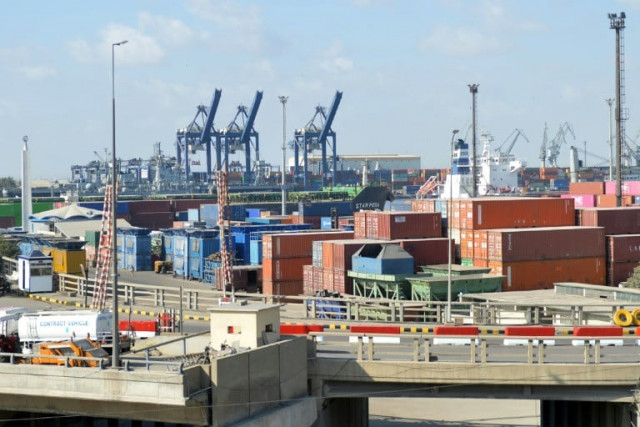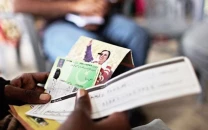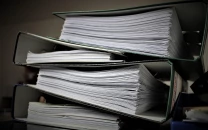Economy shrinks from 6.1% to 0.3% under PDM govt’s watch
Curbs on imports leave industrial sector crippled

Pakistan’s economic growth rate plummeted to 0.3% in the outgoing fiscal year due to severe restrictions imposed on the imports in an effort to avoid sovereign default, leaving the industrial sector crippled with spillovers on the services sector.
The 0.29% growth rate is the lowest increase in the national output in the past four years that exposes the mismanagement of the economy that is highly insufficient to meet the needs of 250 million people.
Despite severe floods, the agricultural sector still posted 1.6% growth, beating all forecasts of contraction due to a devastating impact on crops. The industrial sector contacted by 2.94%. But the services sector -- the single largest sector in the economy -- showed nominal growth of 0.9%.
The government has missed all sectoral targets, thanks to its economic mismanagement that also caused massive layoffs and contributed towards the 59-year-high inflation rate of 36.4%.
The National Accounts Committee, in a controversial fashion, met on Wednesday night and approved the provisional Gross Domestic Product (GDP) growth rate for fiscal year 2022-23, ending on June 30. Planning Secretary Zafar Ali Shah chaired the meeting.
The outgoing fiscal year will be marked in Pakistan’s history as the one when the country had experienced devastating floods that washed away crops, a highly mismanaged economy and a steep fall in the purchasing power of the people due to the record inflation.
The government has inflicted heavy losses on the economy by devaluing the rupee and increasing the utility prices in the hope of the getting a deal from the International Monetary Fund (IMF). In the end, neither the IMF programme could be revived nor could the economy be saved from disaster.
The provisional Gross Domestic Product (GDP) growth rate for the year 2022-23 is estimated at 0.29%, announced the planning Secretary after a meeting of the National Accounts Committee.
The government postponed the NAC meeting four times in one week due to disagreement over the increase in national output, according to the sources. Some officials of the Pakistan Bureau of Statistics shuttled from one office to another to reach a consensus, the sources added.
It is a recession in growth, but not an overall recession in economy, said Dr Nadeem Javaid, chief economist of the Planning Commission.
There was broad-based slump in the economic output, mostly because of the government’s mismanagement and also adverse impact of the floods. The GDP is the monetary value of all goods and services produced in a year.
The nearly 0.3% growth rate was far lower than the official target of 5% and in line with the estimates of the Ministry of Finance, the State Bank of Pakistan, the International Monetary Fund, the World Bank and the Asian Development Bank. All the institutions predicted the 0.2% to 0.8% economic growth rate.
The figure is provisional and subject to variations once the final results are available at the end of the fiscal year. The economic growth rate during the last year of the PTI rule was 6%, which was further adjusted by the NAC on Wednesday to 6.1%.
Even the provisional nominal growth rate may become controversial after initial estimates suggested normal contraction. Renowned economist Dr Hafiz Pasha has estimated that the economy has in fact contracted by over 3% during the outgoing fiscal year.
The details showed that the massive curbs on the imports and consumption pulled down the economic growth rate, which has already triggered a serious external sector crisis – an identical pattern witnessed in 2018 when the country fell in the lap of the International Monetary Fund.
Last year, there was 6.1% growth rate - the end of the Pakistan Tehreek-e-Insaf government – which was the highest in four years. The last time, the country attained a 6.1% growth rate was in 2017-18 – the last year of the PML-N rule, which was also driven by consumption and imports and took the country back to the IMF.
During 2017-2018 and 2021-2022, Pakistan’s growth was largely financed through foreign savings, which is highly unsustainable. Against the official target of attaining 3.9% growth rate, the agriculture sector is provisionally estimated to grow by 1.6%. The growth appears surprising and could be the result of adding value addition of around Rs500 billion flood expenses.
The floods washed away major crops that not only created food shortages but also wiped out people bread and butter. In the last fiscal year, the agriculture sector grew 4.3%.
The agriculture sector grew on back of better crops of wheat (27.6 million tons) and sugarcane (9.1 million tons), said Chief Statistician of PBS, Dr Naeem ul Haq.
The chief statistician denied that there was any pressure on him to turn negative growth into positive territory.
The industrial sector contracted 2.94% against the target of achieving 7.4% growth.The government itself suffocated the industrial growth by placing curbs on the imports that led to shortage of the raw materials and consequential closure of the factories. Still, the contraction appears less than signs of steep slow down in major industries.
In the past fiscal year, the industrial sector grew 6.8%. The State Bank of Pakistan also increased the interest rates to a record 21% in the hope of containing inflation. But yet the central bank failed to curb the inflation that has already crossed to 36.4%.
The government had set the growth target for the services sector at 4%. But according to provisional numbers, the services sector showed marginal growth rate of 0.9%. In the previous fiscal year, the services sector expanded 6.6%, according to the NAC.
The NAC also revised the economic growth rate upward for the second last year of the PTI government from 6% to 6.1%. The final growth rate of GDP for the year 2020-21 revised to 5.8%.



















COMMENTS
Comments are moderated and generally will be posted if they are on-topic and not abusive.
For more information, please see our Comments FAQ